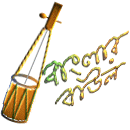The Bauls of Bengal
Robert Menger, November 28, 2000
I. ABSTRACT
The Bauls of Bengal believe in a religion largely based on ideas from Hinduism, Islam, and Buddhism. It is the Bauls disregard of social constraints, such as the caste system, which leave them free to achieve liberation through the realization of the Divine. Lalan Fakir, who is the oldest recorded writer of these songs, developed the majority of Baul songs. In the Baul religion, individual inquiry and empshasize on the importance of a persons physical body are important because it is within the body and the Supreme resides and thus it is the only place people need to search for God. The basis of Baul ideology is to achieve the spiritual objective of liberation. Baul songs were invaluable to the maintenance and preservation of their religion. Songs were used for instruction by the guru to teach his disciple and to prepare him for the ultimate truth. The goals, of the Baul practitioner, are to achieve the realization of the Supreme using both yogic and tantric techniques.
II. Scope and Purpose of the System
The Bauls of Bengal belong to an unorthodox devotional tradition, which has been influenced by Hinduism, Buddhism, and Islam, yet it is distinctly different from all three. The Bauls tradition is eclectic; its influences come from tantric (Sahajiya) Buddhism, tantric Hinduism (primarily Vaisnava Sahajiya, but also Saiva-Sakta), Bengali (Gaudiya) Vasinavism, and Sufi Islam (Dimock 260-62). Bauls consist of both economically and socially marginal groups. They identify themselves with neither Hindu nor Muslim society. The majority of Hindu Bauls residing in the state of West Bengal in northeastern India, and most Muslim Bauls live in Bangladesh (Lopez 187). Monks, ascetics, homeless, and married men compose the society of the Bauls. Caste, special deities, temples and sacred places play no part within Baul ideology. They do not set up any images of divinities or religious symbols in their own places of worship. They believe the temple where the supreme resides is in their own body (Tagore 210).
Bauls go from village to village, singing, with their ektaras, which is a simple one-stringed instrument, and drums called dubkis. The Baul earns most of his living from his songs, which he sings traveling from door to door (Bhatt 26). It is mainly through these songs that they give outward expression of their beliefs and practices (Lopez 187). They are in essence a tantric yogic sect, and share common practices with other tantric yogic traditions. Poetry, music, song and dance are all essential to the Baul and all are devoted to finding mans relationship with God, and to discover the purpose of mans existence (Reymond 242). Kaya Sadhan (Realization through the body) can be realized by a spiritual undertaking (Tagore 218). In order to gain real freedom, one has first to die to the life of the world while still being alive in order to get rid of worldly desires. The Baul must defeat necessity in order to achieve his or her liberation (Tagore 209-210).
III. AUTHORITY STRUCTURE:
A. Sources and Criteria of Valid Knowledge:
Reason is an inadequate tool when one is dealing with the intangible. The Bauls life is balanced between knowing and unknowing, of life with death (Bhatt 36). The Baul is not an intellectual. He possesses simple and natural wisdom. Bauls do not accept the organized system yet he accepts the faith because it results from natural trust. This trust springs from the Adhar Manush, the unattainable man, who resides in the human form.
Ritualized religion produces habits and customs, which prevent one from being alert for the man of the heart. Religions sometimes produce formalities, which can become to people more important than God (Bhatt 37). Baul philosophy is not developed in any sacred writings and the Baul does not depend on any tradition. Above all else, intuition guides the disciples (Reymond 242). Bauls do not accept inference, and without physical existence, they have no ritual practice. Baul spiritual practice focuses on the body. Without reference to the body, practice is considered irrelevant and imaginary (McDaniel 180). The followers of the sahaj cult believe only in living religious experience. Truth, according to them, has two aspects, inert and living. Truth has no value for man until it is part of a living person. The guru or master is the one who makes the truth for the Bauls living (Tagore 215). As is true of mystics in general, the Bauls believe that the truth cannot be found in books. They reject the authority of Hindu scriptures such as the Vedas and Puranas as blinding one path to the divine (Lopez 191). Like the Sahajiyas, the Bauls are strongly opposed to the study of the Vedas and the Puranas, which according to them only make men confused. Bauls believe, as do the Sufi mystics, that the ultimate truth cannot be grasped through intellectual knowledge or reasoning but can only be realized within oneself using the power of love (Datta 450).
B. Methods of Inquiry
The pain of being apart from the Divine cannot be eased by textual study, debate, or even prayer for the Bauls (Tagore 216). Baul songs must be approached with a softness of feeling and a meekness of spirit (Dimock 159). Freedom of spirit provides the Bauls with natural inclinations of the mind, which are not restrained by social institutions. Their ideology proceeds in a direction opposite to that followed by the general public. Bauls avoid all religion in which the natural goodness of the soul is overshadowed by ritualism and ceremony. It is for this reason that the Bauls call their path ulta (the reverse) path and think of the process of their spiritual advance as the process of proceeding against the current (Dimock 163).
Like other tantrics, they hold that the body is a microcosm of the universe in which the Supreme resides, and that it is the only instrument for gaining liberation and conquering death (Lopez 191). If one desires to achieve the knowledge and realization of the Supreme then one should focus on the inner being. Within the Baul discipline, the physical body must be kept exceedingly pure for it is here the Bauls believe that the temple of the Supreme exists (Reymond 243- 44). Sexuality plays an important part in the Bauls search for the ultimate truth.
Ritual practice is largely disputed among the Bauls. Those for rituals believe they are mandatory to achieve the desired state of perfection. In contrast, other feel ritual practice is only necessary when a person does not have a close relationship with the Divine (Mcdaniel 185). The Bauls use a process called Urdha-srota, (the elevation of the current), in order to convert the currents of jiva (animal life) into the current of Shiva (God life) and bring about a realization of the Supreme within a person (Tagore 218). Gobinda Das, a Baul songwriter, believes it is foolish that some people pray, make pilgrimage, or fast in order to find God. He feels God exists on its own, extremely infinite and having many shapes (Bhatt 60).
Like the tantrics, the Bauls believe that the means to experience divine love is through human love; through the union of the physical forms of man and woman (Lopez 191). Bauls practice sexual intercourse with seminal retention during a womans menstrual period. The aim of these rituals is to reunite the dual principles that were separated when the world was created. The Bauls seek to reverse the cosmic process that leads to death and rebirth. The active form of the Supreme, called the sahaj manus becomes manifest in the lowest cakra, the mudladhar, during a womans menstrual period. It is at this time that the Bauls perform their sadhana to catch him. (Lopez 194) For sadhana to be successful it is necessary to bring under control the six enemies (lust, anger, greed, infatuation, vanity, and envy). The male practitioner envisions himself as a woman in order to change his lust into true love by preventing semen loss (Lopez 195).
If one realizes the truth of the body (bhanda) one will be able to realize the truth of the universe (Brahmanda) (Datta 451). The ideas the Bauls have about the composition of the body do in most cases go against the standards of modern science. One proof of the validity of their system lies in the appearance of madness in certain Bauls. This madness is not an effect of their separation from God, but instead from direct visual manifestation (darsana). The appearance of madness shows that the Baul has seen the Supreme thus confirming the authenticity of his practices (McDaniel 190).
C. Institutions and Professional Structure
Religions that reject scriptural authority place great importance on guides who lead those seeking to learn the practices of a tradition. The practice, preservation, and teaching of the Baul religion rest heavily on the guru or teacher. In the case of the Bauls, the guru or murshid is not just a regular person but also an intermediary through whom God relays his teaching and guidance. Bauls consider the guru to be the divine in the shape of a human being or in some cases the Supreme himself. The Guru is the only person that can bring about knowledge in the disciple and guide him toward the realization of God, thus the guru demands as much devotion as the Supreme would (Datta 448). This dedication toward the guru results in the disciple coming closer to the gurus perfected state and the grace of God (McDaniel 161). Even though the Guru is highly praised and esteemed, the disciple has no responsibility toward the master and is also free of any commitments.
Baul songs, along with music, play a major role in the oral communication of Baul ideas and beliefs. These songs were not used for propaganda or to convert people to the Baul tradition but used instead to relay teaching and instruction from the guru on down to disciple (Bhat 11-13). Baul songs are never recorded into book form. (Tagore 211) The importance of the teacher (guru) - pupil (shishya) relationship is seen by both Hindu and Muslim Bauls alike. They both believe that this divine relationship was developed by God himself (Reymond 243). The all-knowing guru does not make the disciple renunciate the pleasure of the world, but instead stresses the development of a new higher self, which cannot be found in any text (Tagore 219). Baul songs were composed by the part of the sect that had reached maturity through spiritual union. They, in turn, tell about the power of their realization to their disciples (Lopez 192). The guru-sishya system is of extreme importance in the tantras especially the Bauls who deal with the practical side of Sadhana that involve yogic exercises. In the Baul tradition, no disciple can attempt to find the ultimate truth without the instruction of the all-important guru (Datta 448).
IV. History
The Bauls, who do not belong to the orthodox traditions of India, embody spiritual life, which remains alive even today. Baul ideology is believed to have existed before that of the Vedic religions (Reymond 246). The name Baul, however, first appears in the literature of Bengal only in the fifteenth century. It seems to derive from the word batula meaning he who is beaten by the winds he, that is, who abandons himself to all his impulses. But this ecstatic madness has to do with their love for God (Reymond 246). Scholars have placed the origin of the Baul sect anywhere from the fifteenth to the seventeenth century.
Baul songs provide no clues as to how far back the tradition goes. They are primarily transmitted orally from guru to disciple and from singer to singer. The language tends to be modernized thus giving no indication of the date of composition. Brajendranath Sil feels that the birth of the Bauls took place near the end of the fourteenth century or the beginning of the fifteenth. But it was after this in the sixteenth century that the Baul religion began to spread rapidly. Between the fourteenth and seventeenth centuries the Bauls got their iconoclastic nature when it swept across northern India. It was this same presence that brought about santa cults, which in turn affected the Sufi Islam. There are a few points of similarity between the Bauls and other sects around them (Dimock 254-256).
The Nobel laureate Rabindranath Tagore, who is considered by some to be a Baul is credited with bringing Baul songs to the attention of middle-class Bengali society (Dimock 258). It was mostly Tagore and his associate Ksitimohan Sen, who elevated the Bauls to the status of a cultural symbol. In 1968, Upendranath Bhattacarya wrote about the Bauls and proved that Bauls whether Hindu or Muslim practice almost the same sexual rites and that these rites are important to Baul religion and to a comprehension of their songs.
Although there are many outstanding Baul poets, Lalan Fakir also known as Lalan Shah is considered to be the greatest of them all. Lalan was very popular in West Bengal and Bangledesh and he has had a great impact on Bengali literature as well as on Baul tradition. Lalan declared that there was only one true religion and that it was the religion of man. The songs that he composed which are numerous are the believed to be the oldest dated songs. In addition, these songs form the basis of Baul ideology and the basis for scholarly discussion (Lopez 188). The word Baul cannot be traced in medieval Bengali literature. The word derived either from Sanskrit vyakula confused or vatula mad is found in Bengali texts dating back to the fifteenth century where it generally has its literal meaning mad. The Baul tradition reached its fullest potential in the last century and the early part of the present one. During this time period the basis of the Baul religion was developed through the creation of songs (Lopez 189). Most recently a group of Baul singers can be heard on Pink Floyds new album, demonstrating their longetivity (Lopez 189).
V. Representative Examples of Argumentation
The traditional image of the holy man is a controlled yogi, peaceful and strong, To the non-Baul, the madman (ksepa) of which belong many Bauls are viewed as illogical and possessed. The Bauls defend this allegation by explaining that it is the Bauls disinterest with the world and also his extreme emotional states, which make seem mad. For the Baul, madness shows devotion to a spur-of-the-moment love that goes against established social rules. The madman does not hallucinate, but rather sees the truth (Mcdaniel 158-59). The experience of the Supreme can often make Bauls appear bewildered and cause him to ramble but this is because to view the Divine the Baul must do the opposite of what normal society says (McDaniel 185).
The Bauls hold the body as the means to achieving salvation. Thus they defend themselves against other religions that see the body as creating obstacles toward a person achieving salvation. Some religions worship in temples, but the Bauls believe the only temple is the human body (Tagore 210). The Bauls defend their rejection of the caste system by saying, Are the lower planks of a boat of any lesser importance than the upper (Tagore 213) In addition, people ask the Bauls why they do not pay attention to the scriptures they reply, Are we dogs that we should lick up the leavings of others Brave men rejoice in the output of their own energy, they create their own festivals. These cowards who have not the power to rejoice in themselves have to rely on what other have left. They are content with glorifying their forefathers because they know not how to create for themselves (Tagore 214). Bauls also explain that their cult has no age because their real religion is not constrained by time, unlike the Vedas and Puranas, which they feel are artificial (Tagore 215). The Bauls depart from the majority of tantric traditions and most closely resemble the Sufis and the Vasisnavas, both orthodox and Sahajiya, is in the importance they attach to love in the realization of the divine.
Like Sufis and orthodox Vaisnavas, the Bauls see love as the longing of the individual for the Supreme (Lopez 190). Although the tantric conception of the deity is at core of their belief, the Bauls intense feeling of pain at being separated from the divine is expressed in song after song, reflects the influence of Vasinava and Sufi traditions (Lopez 192). The Bauls like other tantric yogic practitioners, conceive of the body as having two forms. There is a material or gross body made up of skeleton, muscles, organs, and having nine or ten openings or doors. The other form is the subtle body. Their conception of the subtle body for the most part resembles that of the Hindu tantras and of other yogic texts, but also reflects the influence of Bengali Sufism (Lopez 192-93).
VI. Suggested Position in Comparative Scales
a. a. Relative emphasis on traditional authority (1) ----- or the testimony of experience. (10)
Rating:9
The Baul religion is completely based on ones experience in the realization of the divine. It is the disciples feeling of longing for the Supreme and the resulting madness that demonstrates that he feels reunited with the Divine.
- Reative centralization of authority (1) --- or decentralization (individual inquiry, lay authority). (10)
Rating: 10
Individual inquiry is the basis of the Bauls religion. There is no centralized body, which makes rules to follow. It is the individual who must come to find the ultimate truth on his own under the guidance of a guru.
- Relative emphasis on invisible (spiritual or heavenly) realities (1) ----- or material, earthly ones. (10)
Rating 2
The religion of the Bauls is based on spiritual awakening and is a search for the heavenly. Much of the their practices involve invisible acts that are accepted as reality by the followers of the religion.
- Mainly spiritual or moral objectives (1) ----- or pragmatic aims (prediction, healing, etc.) (10)
Rating 2
The objectives and the motivation behind the Baul religion is the quest for spiritual realization of the man of the heart. Their spiritual objectives are to catch the Supreme within their own body.
- Most power or agency reserved for a divine being (1) ----- or realizable in individuals. (10)
Rating 10
The religion of the Bauls belief is that the Supreme lives in the heart of human beings. If one performs Sadhana and the proper yogic practices it is possible for the individual to achieve liberation and to be reunited with the Divine.






 The word Baul means "afflicted with the wind desease", minstrels, uncaring travellers, selfless wanderers, lost in search of their souls, street walkers, ones with no fixed address, ones who find happiness in richness of their minds, etc. Much of the Bengali society looked upon the bauls as strange people who forsake all comforts and binds of the family life and chose streets as their home and austerity as the way of life. Customs and traditions they leave behind on the wayside.
The word Baul means "afflicted with the wind desease", minstrels, uncaring travellers, selfless wanderers, lost in search of their souls, street walkers, ones with no fixed address, ones who find happiness in richness of their minds, etc. Much of the Bengali society looked upon the bauls as strange people who forsake all comforts and binds of the family life and chose streets as their home and austerity as the way of life. Customs and traditions they leave behind on the wayside.



















